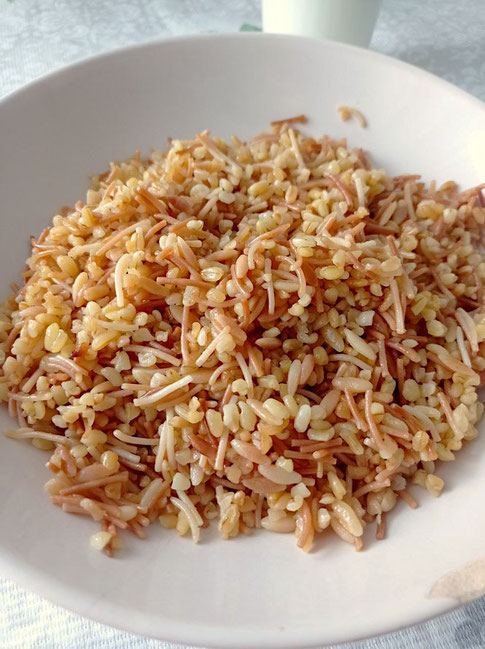
Team Bulgur, Team Bulgur, 100x Team Bulgur. Many people and I agree that bulgur tastes better than rice. It simply tastes like more. At the same time, bulgur has more bite and simply tastes more interesting all round than rice. But okay, you don't have to badmouth other things to prove how good something is :-) Let's leave it at the fact that simple bulgur pilaf is delicious as a side dish.
However, we already have a recipe for bulgur as a side dish on the blog. So what's the difference here? Bulgur as a side dish is often prepared with tomatoes, peppers, onions and the like - it tastes great! This time, however, we were in the mood for more simplicity. That's why we're making our simple bulgur pilaf more pure today.
What goes into our bulgur pilaf?
This bulgur side dish is really golden, pure bulgur. However, to round off the flavor, a little more is added to the bulgur pilaf. We have used Tel Sehriye* (soup noodles, vermicelli). Alternatively, you can also prepare the simple bulgur pilaf with arpa Sehriye* (risoni) or without any of these at all. In this sense, this bulgur recipe is prepared in pretty much the same way as classic Turkish rice.
Because in addition to the Sehriye, the focus is on... butter! The buttery aroma, the cereal taste of bulgur and a few Sehriye for an extra kick are simply delicious in combination. You can also use this bulgur pilaf recipe as a basic recipe. You can therefore also use other fats and oils (such as fat tail sheep fat or vegetable oil) or add a little stock. The important thing is that the bulgur is nice and fluffy and never mushy – and that's exactly what our recipe achieves!
Which bulgur to use for this pilaf?
The world of bulgur is big. In Turkey, you can find an incredibly large selection of bulgur both at the market and in open spice and storage stores as well as in the supermarket. Some bulgur is particularly coarse and others are somewhat finer. There is also bright golden bulgur and brown bulgur - the choice is yours. In the photo you can see that our bulgur, for example, is comparatively small, almost like rice. Personally, we like bulgur bigger than this, but we only had this bulgur at home.

What is important when choosing bulgur as a side dish, however, is that it is "pilavlik", i.e. suitable for "rice dishes". Here we are talking about coarse bulgur. There are also all kinds of fine bulgur, which is used for salads, cigköfte or icli köfte. However, the moment a bulgur is coarse or "pilavlik", it is ideal as a pilaf.
You can see the difference between different types of coarse bulgur in the two links/offers below. The first product is very coarse and the bulgur is correspondingly large, but also has more bite. The other bulgur is slightly finer, but still coarse. It is similar to the bulgur we used for our side dish.
What does bulgur go well with as a side dish?
Bulgur is a common side dish in Turkish cuisine and you can really serve it alongside all kinds of recipes. How about bulgur alongside sulu köfte or orman kebabi, for example? You can also prepare our tavuk kapama with bulgur instead of rice. Do you prefer vegetarian/vegan? Then bulgur goes perfectly with chickpea stew or kuru fasulye. We served it alongside taze fasulye, i.e. Turkish-style green beans.
In short, bulgur as a side dish is a great alternative to rice, pasta, quinoa or even potatoes and the like. We therefore think that no household should be without a bag of bulgur. Afiyet olsun!
Sade bulgur pilavi: simple bulgur recipe as a side dish
Ingredients
- 1 cup (approx. 200 ml) bulgur
- 2 tbsp soup noodles (vermicelli)
- 1 full tbsp butter
- 2 cups water
- salt
Note: Bulgur/water ratio is always 1:2
Preparation
Step 1: Put the soup noodles in a pan with the butter and let them brown a little over a medium heat. Make sure they don't burn.
Step 2: Add the bulgur to the browned soup noodles, stir everything together and fry for a good two minutes. Keep mixing and make sure nothing burns.
Step 3: Pour water and salt into the pan. When the water boils, close the pan with a lid and turn the heat down to low (level 2-3). Do not open the lid from now on under any circumstances! When the water has evaporated, turn off the heat, but leave the bulgur on the stove and the lid on the pan. After at least 10 minutes (the longer the better), you can open the lid, mix the bulgur pilaf and serve it hot as a side dish.

Write a comment